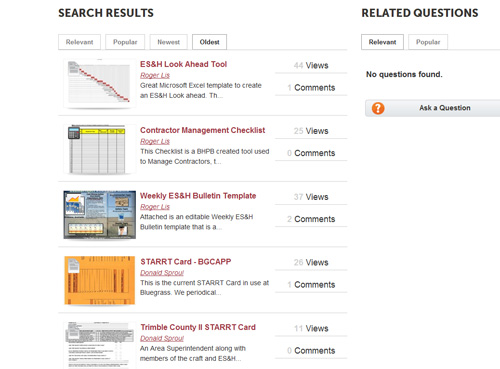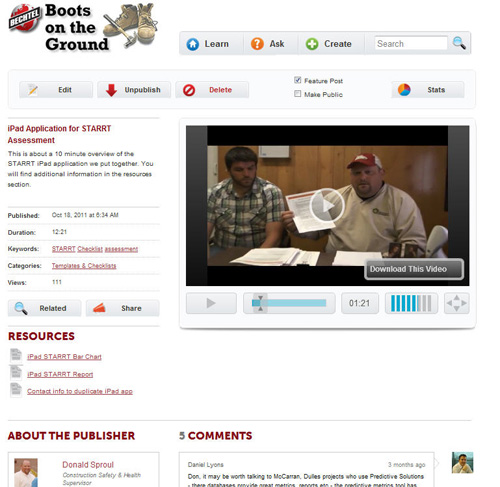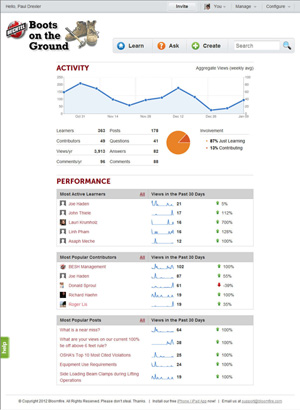Introducing learning innovation into a large traditional corporation is a bit like prospecting. It requires a delicate combination of skill, timing, and luck to overcome not only the expected resistance to change but also the general lack of influence that is the lot of most learning organizations.
At Bechtel, a global engineering and construction company, projects are the heart of the business. Many of our 52,000 employees are working on projects across six continents and on mega-projects so large that they could be stand-alone business themselves. For a company of this size and global dispersion, our Learning and Development department is relatively small. The department’s traditional role, creating courses and using a learning management system to track results, gives us little connection to the projects, making the challenge of introducing learning innovation even greater.
Undaunted by these obstacles, in 2009,we launched the Bechtel Learning 2.0 Challenge to learn how we might use Web 2.0 effectively for learning and to connect with our audience. The Learning 2.0 Challenge was a competition in which we challenged Bechtel's employees to develop an approach using Web 2.0 tools to improve learning effectiveness. The challenge was extremely successful; participation was triple what we anticipated; and we were impressed by the technical quality and imagination of the finalists’ entries. In addition, the competition helped attract more favorable attitudes to Web 2.0 from Bechtel senior management. We approached 2010 with cautious optimism and looked for ways to introduce Web 2.0 and informal learning into the corporate fabric.
Make sure the nail fits your hammer
Our first task was to find potential partners who had a real business need. It is better to first find a business need and then see if your solution fits, rather than begin with a solution and try to make every business need fit. Finding a fully committed partner is also vital to success.
In June we found both, or rather they found us. Don Sproul and Brad Dowell, two experienced safety professional supervisors, were referred to us by the Environmental, Safety, and Health (ES&H) learning manager. Since Bechtel has a well earned reputation as a safety leader we knew we had the right partners.
Don and Brad delivered a presentation on Construction New Technologies and Best Practices at the 2010 Bechtel ES&H Conference. The response was so enthusiastic that they wanted to establish an ongoing community to continue the dialogue generated at the conference and were looking for a platform that would support this objective.
Don explains, “Brad and I shared frustrations about not having a common place at Bechtel to share best practices, find out about new technologies, and find out about what other projects are doing. This issue was even more challenging for new employees. Generally the only people who learn what other projects are doing are managers within a business line. Brad and I wanted to exchange information and ideas, and get validation from other sites.”
As it happens, after the Learning 2.0 Challenge, we had been researching the use of social media platforms such as Yammer, Ning, and CubeTree to support communities of practice (CoPs) in an enterprise setting. After analyzing a number of platforms from a CoP perspective, we observed two basic platform approaches, one from Facebook and the other from YouTube. The platforms using the Facebook approach were people-focused and used micro-blogging (or status updates) as the central organizing feature of the user experience (Figure 1). The platforms using the YouTube approach were content-focused and used popularity of a piece of content combined with robust search capabilities as the central organizing feature of the user experience (Figure 2).
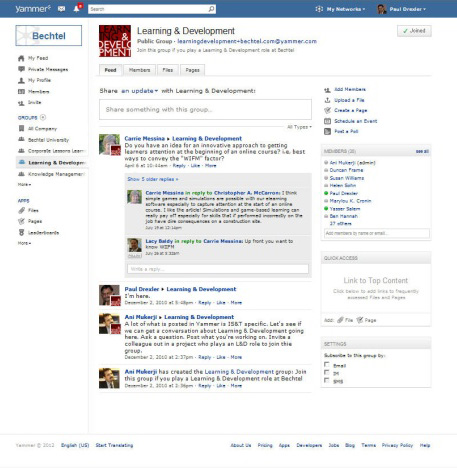
Figure 1. Facebook approach
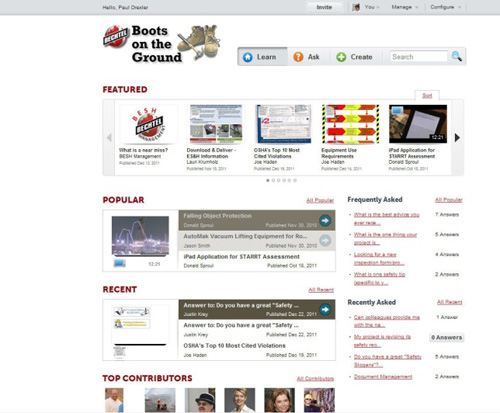
Figure 2. YouTube approach
Another factor was the attitude among older workers towards social media as being insubstantial. “I don’t like Facebook,” Don explained. ”It’s just a chat room, water cooler talk. It’s not a technical resource.”
We decided that for the purpose of the community Don and Brad wanted to start, the content-focused approach was more appropriate. As our platform, we chose Bloomfire (www.bloomfire.com), designed by a former corporate training manager. After using the platform briefly, Brad commented, “You know almost immediately how to use it. It’s easy to post or capture video, text, graphics, etc. It categorizes topics and can be searched easily.” After that, we knew we had the right tool… now we needed just to figure out how to use it.
By the people and for the people
We knew that for the target audience of this CoP, Bechtel employees on our project sites, the website must quickly prove its value. Members should immediately see how the site could make their jobs easier and help them improve safety and quality on their project. We did not want members to regard the CoP as a flavor of the month or yet another machine that had to be fed something that would generate an additional action item to their work days
Because we were asking people to participate on their own time, it was important that the tone of the site reflect their voice and not that of corporate headquarters. Our CoP was bottom up, a community by the field for the field. The goal was to be a first-stop resource within Bechtel for new technologies, tools, solutions, and best practices for employees on Bechtel projects. While the site was primarily safety oriented, it also needed to be valuable to people in engineering and construction. The title “Boots on the Ground” (BOTG) reflected this goal.
Here is a part of our mission statement:
If you are tired of reinventing the wheel, if you want answers without having to look through six different places, this site may be for you. If you have ideas and knowledge you want to share, if you want to learn what people in other disciplines, sites, and GBUs in Bechtel are doing, this site may be for you. If you want to locate an old school mate or find out what people have been doing in the last 15 minutes, you may want to go someplace else. (If the #$%@ has hit the fan and you need to talk to someone who’s been there before, this site may help.)
You get the picture.
Don’t activate the corporate “immune system”
We used a strategy that had proved successful in the company on previous projects: start small and don’t make waves. We removed the word “initiative” from our vocabulary and substituted the word ”Pilot.” For the C-level executives the word “initiative” generally precedes a large budget request. The cost of our platform was low, so we were able to keep BOTG a small self-funded pilot.
Make your barriers into stepping stones
Whenever you introduce change you are sure to encounter barriers. Our approach was to figure out what the barriers would be and offer solutions. We identified four barriers.
1. The Management Barrier: Risk
We knew going in that the most important concern of management would be risk avoidance. Instead of the traditional top-down learning approach, the community of practice would allow sharing knowledge more easily, with fewer checks and balances. Management preferred that only best practices approved by experts be shared, and were concerned that unrestricted information sharing could lead to problems
“Suppose someone posts a faulty construction technique on the Website and someone else uses this technique on a project. If a failure occurs there could be serious consequences”
This was an understandable concern, shared by executives at most other large corporations. At the same time, we strongly believed that establishing a pre-screening process would cripple participation. If people had to wait to see their contributions on the site, they would lose interest and trust in the community. Bureaucratic procedures such as this had prevented a Corporate Lessons Learned site (launched earlier) from being widely used. To mitigate such concerns, we met with a senior counsel in our Legal department, walked him through some participation scenarios, and discussed specific strategies on how to mitigate risk in each of them. We also agreed to implement specific codes and procedures, many of which were built into Bloomfire’s architecture, including:
- Site accessibility only to those with Bechtel email addresses
- No anonymous posting. Every post was identified with the name of the author
- Administrators were notified as soon as anything was posted on the site. We agreed that all posts would be reviewed within one day and taken off if inappropriate.
- Clear community guidelines (Figure 3)

Figure 3. The Guidelines for the Boots on the Ground Community
To this date, no inappropriate posts have appeared
2. IT is your friend. Don’t make IT your enemy
When introducing any technology related solution into a corporation, you are sure to run into the IT (at Bechtel it is IS&T) department sooner or later. Do it sooner and make IT a partner rather than a potential roadblock. We shared our rationale behind selecting our platform with IS&T to make sure that it did not conflict with their long-term plans, and we received clearance to use it. Since we had the ability to download content on the site at any time, we knew that whatever future IT decisions were made, we would not lose the content that had been developed by our members.
3. Alignment
If possible, we wanted to align our efforts with a corporate initiative. Luck and timing were on our side. Corporate programs to improve quality began around the time we were preparing to launch the community. Interest in improving learning had grown significantly, aided by a younger generation of workers. In addition, a timely article in the Harvard Business Review on Communities of Practice put this topic on management’s radar. Management started considering more active support of Communities of Practice.
4. Roles and responsibilities
We knew that having the right combination of roles and responsibilities would also be crucial to the success of the CoP. The site belonged to ES&H. It was this group and the members of the community that would determine the direction and the success or failure of the site.
Our learning and development role was to use our strengths in instructional design and communications, and our relationships throughout the company to support the community. Our position in corporate gave us a wider, more strategic view of the company, and our relationships throughout the company helped us locate new members, opportunities and partners.
Site launch
Don and Brad’s conference presentation gave us the content to populate the site with short videos illustrating products that improved safety or efficiency on the job. For the first few months the site grew by invitation only. The value of community members in one project having direct communications with other projects quickly emerged. People from different projects began sharing all kinds of safety procedures, check lists and best practices. A person on a new project could find and use check lists developed on other sites instead of having to create them from scratch. (Figure 4)
Figure 4. The Search feature
makes it easy for Community members to locate checklists from projects other
than their own, reducing the need to “reinvent the wheel.” (Click image to enlarge)
The site also became a place to gather other information that was previously unknown to a wide audience. In May 2011, after returning from mLearnCon, The eLearning Guild’s mobile learning conference, we posted a question on the BOTG site asking people what mobile applications they would like to have, if available. To our surprise, we soon learned that iPad use was quickly growing at Bechtel projects and that the community members were already developing and using a number of mobile applications that made collecting data, issuing checklists, and accessing project site information more effective. (Figure 5)
Figure 5. iPad apps turned
out to be an area of high growth in the Bechtel community. (Click image to enlarge)
As the site continued to grow and show value, direct executive support increased. At the 2011 Bechtel ES&H conference, the CoP was officially announced and the corporate ES&H manager sent invitations to all ES&H employees. Our membership doubled within a month.
Since that time, people from other disciplines such as engineering and construction have become members in increasing numbers
In December 2011, OSHA (Occupational Safety and Health Administration) gave Bechtel’s Bluegrass Chemical Agent-Destruction Pilot Plant project its highest possible (Voluntary Protection Program) Star rating. A VPP Star rating is extremely rare, and it exempts a project from OSHA programmed inspections. The OSHA Region IV assessment team specifically called out the BOTG Learning Community as an Area of Excellence in its final report.
Looking forward, looking back
In little over a year, with only part time resources, BOTG has grown from five to more than 350 members. Members have shared more than 100 best practices, tools, templates, and checklists, and nine iPad applications, developed on different Bechtel projects. The community has now reached a critical mass where there’s enough new content being posted by members of the community to keep the community “fresh” and the day-to-day support provided by the site administrators has gone down. That said, we realize that our work is not done.
ES&H management has been supportive of BOTG but we would like to increase their active participation. Some additional technical features have been requested, particularly the ability to rate contributions.
We want to develop a program to publicly recognize top contributors of the site. We also want to analyze the traffic within the community to identify topics that employees believe are critical to their success but which are currently not being served by our formal learning offerings. We also want to use community participation patterns to help identify experts on the topics regardless of their position within the corporate hierarchy. We will be exploring ways to share the knowledge created outside our community using knowledge capture and transfer. We will need to learn how to integrate with other communities, the corporate information architecture, and the formal learning infrastructure.
A critical success factor in sustaining our community will be funding a community coordinator who will support the community, encourage relationships, and look for ways to grow the community. For the moment though we are enjoying the satisfaction and discovery created when people are allowed to contribute their talents in a meaningful way.
Lessons learned
Through our efforts in this space, we have learned some key lessons about building informal learning and knowledge sharing communities. (See Sidebars 1 and 2.) They require the right mix of formality – focused topic areas, and informality – ability to post content and comments without prior expert moderation. Because such communities are voluntary activities in a work world filled with deadlines and formal goals, the level of frustration that audiences will accept is low, and site content must align with the goals of the community and provide “instant” value to the members.
Platform Features
We found that the following platform features help in building communities:
- Good usability in all aspects of user interaction with the site
- Simple and focused design that quickly highlights key content and contributors to anyone who visits the site (Figure 6)
- Ability to identify a user’s area of expertise based on the contributions a user has made and the responses generated from those who have viewed the content
- Good search capability
Figure 6. The simple and
focused design of BOTG quickly highlights key content and contributors. (Click image to enlarge)
We also found that some platform features may hinder building community:
- Platforms that have microblogging/status updates as a central organizing feature (e.g., Facebook, Yammer, CubeTree)
- Platforms that don’t allow users to post common media types such as photographs or videos
- Platforms that rely on administrators to provide a framework for organizing content (categories, taxonomies)
- Platforms that require technical ability from the administrators. The site should be considerably easier than SharePoint to administer.
- Platforms that require moderation prior to publication of user-generated content
Types of CoP Members
There are typically four distinct types of members in a CoP:
- Learner/User
- Contributor
- Moderator/Administrator
- Sponsor
- Learner/User
Learners/Users are those who may visit the site on a casual or a regular basis. They are consumers of the knowledge on the site but are rarely contributors. They will continue to participate as long as they see value in doing so. This group comprises between seventy five and ninety percent of the total audience. Within the first two to three minutes a learner/user should be able to:
- Understand the purpose of the community
- Have a sense of the organization of the site
- See something that engages or interests them (Just-in-Time learning; see Figure 7)
- Have a sense of how they might use this site
- Have a positive feeling about the site
- Feel safe in contributing or posting content
- Have the ability to connect from mobile devices
- Feel the site is easy to use
- Flag inappropriate content
- Post questions to the community
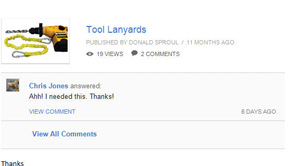
Figure 7. BOTG supports
Just-in-Time Learning – in this case, a learner found the answer to a question
within a post contributed months before his need arose. (Click image to enlarge)
- Contributor
Contributors are the heart and soul of the site. They contribute the overwhelming majority of useful content. This group comprises between 10 and 25 percent of the total audience. For the contributor the site should provide:
- Easy mechanisms for posting feedback
- Recognition for their contributions
- Ability to contribute from mobile devices
- Low frustration factor in posting. (Straightforward mechanism for posting, including media such as video, animations, etc. No glitches)
- Greater visibility to management
- Moderator/Administrator
In the early stages of CoP development a small core group may share the moderator and administrator responsibilities. In the longer term, an engaged moderator/administrator, with overall responsibilities that are an official part of his or her job, is necessary. Ideally the moderator/administrator’s annual review and rewards should be tied to the success of the CoP.
For the moderator/administrator the site should:
- Be easy for a non-technical person to run
- Have the ability to focus on and feature a topic
- Allow moderator/administrator easily to train and assist new users with usability issues
- Have a wide range of automatically generated analytics on participation
- Allow moderator/administrator to easily moderate inappropriate or inaccurate content
- Sponsor
Having an influential sponsor early in the life of such a community is a big boost to participation. The site should enable the sponsor to:
- Use the site as a communication vehicle when needed
- Use the site as an integral part of a learning strategy
- Easily review the site content and contribute content
- Review analytics, including finding out who the top contributors are in the community and identify experts in specific areas




